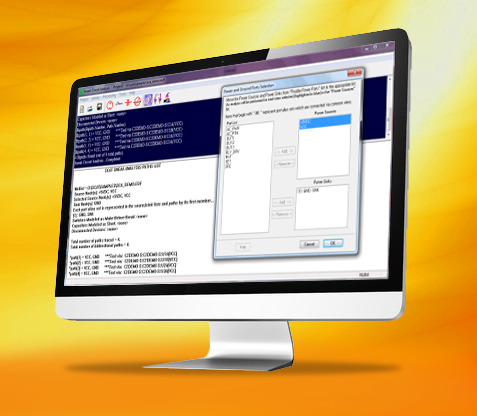Sneak Circuit Analysis (SCAT)
Sneak Circuit Analysis Tool (SCAT) automatically identifies potential sneak paths, power-to-power ties, and design concerns. It focuses on portions of the circuitry, such as a circuit card assembly or a subsystem, power distribution, or complete designs.
The Sneak Circuit Analysis Tool (SCAT) is a Windows-based program that enables engineers to automatically identify potential sneak paths in circuit schematics that may cause undesired outputs or inhibit desired functions. SCAT offers a user-friendly and modern graphical user interface (GUI) that automates both the preparatory work and the actual analysis involved in SCA.
SCAT's GUI provides clear prompts and automated menus when user input is required, such as identifying ports, to streamline the work experience. With SCAT, engineers can easily perform SCA, ensuring the safety and reliability of electronic and electro-mechanical systems.
SCAT 5.4 is a third generation tool based on two previous CAD specific SCA applications and extensive SCA experience.
Hundreds of Sneak Circuit Analyses have been performed on systems ranging from armament control systems and fuzes, through flight control systems to automotive electronic speed control systems.

The automated technique, SCAT, uses an Expert System to analyze a schematic netlist (in EDIF format) to produce a list of parts and topology related design concerns that allow rapid feedback to the designer with resultant benefits to safety, reliability, cost, and project schedules.
AUTOMATED SNEAK CIRCUIT ANALYSIS TOOL
Fully automated process: making use of a unique algorithm, applicable to both early and late stage design, this tool can offer over 10 fold time & cost savings.
Platform independent: making use of industry standardized netlist files SCAT is able to automatically analyze schematics generated with any current CAD tool.
User friendly: SCAT will walk you through the process of identifying components and power ports for an error free and complete analysis of your design.
Auditable results: SCAT generates a complete list of paths and from these it identifies potential sneak paths:
• Reverse current flows (H-patterns)
• Power source to power source current flows (Y-domes)
• Ground-to-ground current flows
• Momentary undesired current paths during switching
Performance: Results are generated within seconds for review, design modifications, and reports.
The SCAT Approach to Sneak Circuit Analysis
SCAT is a Sneak Circuit Analysis tool that differs from conventional SCA techniques. Unlike traditional methods that generate and analyze network trees to identify sneak paths, SCAT does not require or utilize traditional network trees.
SCAT offers an automated procedure that empowers design engineers and reliability analysts to quickly identify and correct sneak paths. The tool exhaustively searches for bidirectional branches, which is easier to automate than searching for specific circuit patterns, as done in conventional SCA techniques. This significantly reduces the analyst's task to evaluating the significance of potential sneak paths instead of applying "clue lists" to identify them.
A critical issue that arises with interconnecting assemblies or subsystem interfaces is ensuring that sneak paths are not overlooked. SCAT addresses this in two ways. First, the system requires the user to identify each interface port of a switching circuit as a power input. Interfaces to power and ground are labeled as such, whether they go to power and ground directly or through switched or un-switched loads, and included in the sneak path search.
SCAT was designed to enable design engineers to perform SCA early in the project life cycle, reducing costs and preventing problems before they occur. With SCAT's automated procedure, engineers can quickly identify and correct sneak paths, ensuring the safety and reliability of electronic and electro-mechanical systems.




